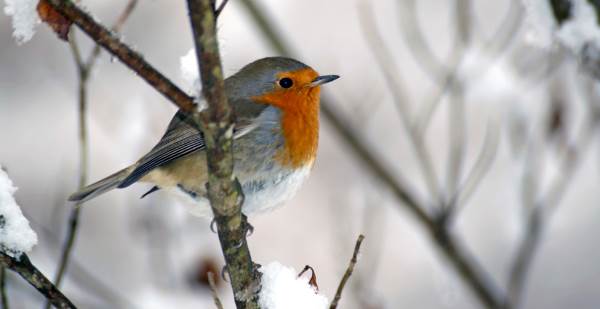Have you ever wondered how birds cope with the harshest winters? The birds during the night, shiver to increase the heat
Have you ever wondered how birds cope with the harshest winters? It may seem strange but the birds, especially during the night, literally "shiver" to increase the body heat, but this tremor takes a lot of energy.
Birds also feel cold, but nature puts them in a position to cope with adversity and climatic events, especially where the winter is not exactly mild. Can we do anything to help them? Let's see what Lipu, the association for the conservation of nature and the protection of biodiversity, tells us, in this sense.
Index
Let's see how and why birds make it through the winter
The feathers
In the meantime, let's start with the feathers. Equip yourself with a good plumage it is the most obvious way to overcome the winter for all those animals that do not face migrations.
“The emperor penguin, for example, is able to face the very rigid temperatures and the blizzards of Antarctica (where temperatures can reach -60 degrees) thanks to an exceptional plumage. To help him, however, there is also body contact with the other individuals of the colony, which allows him not to lose heat ”, explains Lipu.
The shivering tremor
Perhaps few people know, but some birds, especially during the night, they shiver to increase body heat. This shaking system speeds up their metabolism and automatically generates heat. So in practice the tremor caused by the shiver of cold paradoxically helps them to warm up.
"Unfortunately, shaking is not a strategy that works for a long time and above all requires a lot of calories that must be replenished through food," says Lipu.

Gallery
Migration
Many species solve the cold problem through migration which, however, exposes them to long journeys and grueling physical tests. Indian geese, for example, fly over Himalayas at an altitude that can reach 8 thousand meters, with temperatures of several tens of degrees below zero and with very strong winds.
Then there are those who change theirs travel itinerary according to the trend of the season.
“The use of satellite transmitters has made it possible to follow the migration of some cuckoos which, starting from Scotland, undertake a step-by-step migration to Africa. Some of these individuals, heading south, first stop in some woods of England. If the weather conditions are not the best to continue the migration, the cuckoo returns home to Scotland, waiting for better days and thus ensuring its survival ”, explains the association.
But who doesn't migrate?
Species that do not migrate can implement the so-called igloo strategy. Take, for example, the ptarmigan or the black grouse. To solve the cold problem they slip under the snow cover, so as not to disperse energy.
"In the very cold Canadian boreal forest, one of the few species to withstand the winter without migrating is a small tit which, when the temperature drops below minus 30 degrees, stops moving and feeding, since devoting itself to looking for food would involve the consumption of energy higher than that generated by the calories ingested ”, says the non-profit organization.
How to help birds in the winter
We too can do something to help the birds that frequent the cities get through the winter. There are for example blackbirds, robins, still tits and wrens. The best way to help them is to install one manger in the garden or on the windowsill of the house or create balls of grease.
For the manger, there is the "open" one, the one covered by a roof, which keeps away some guests such as corvids, turtledoves and pigeons, and finally the "net" one, specific for tits and nuthatches. You can try to build feeders with your own hands creatively recycling waste or unused objects, such as plates, cups, plastic or glass bottles or even an old dollhouse.
If you want to try it, here we give you some advice:
- 10 bird feeders with recycled materials
What do birds eat?
According to the Lipu, finches, greenfinches and goldfinches prefer corn or sunflower seeds; blackbirds, robins and tits are very fond of sweet crumbs, without disdaining fat and dried fruit. If you then prepare a "thread" of peanuts and coconut, the visit of a nuthatch is not at all excluded.
If you want to try making some balls of fat and seeds:
- Let's help the little birds in winter: how to make balls of fat and seeds
If you want to build a log cabin:
- DIY birdhouses: tips for building them
Why the balls of fat and seeds and not the classic breadcrumbs?
Because bread, eggs and other similar foods are lacking in proteins suitable for the needs of this freezing period. Seeds rich in "good" fats are always the preferred diet.
Follow us on Telegram Instagram | Facebook | TikTok | Youtube


























